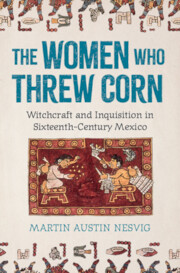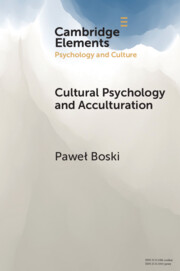Refine search
Actions for selected content:
115 results
Culture, context, and cognition: A meta-analytic review examining the relationship between United States acculturation and neuropsychological functioning
-
- Journal:
- Journal of the International Neuropsychological Society , First View
- Published online by Cambridge University Press:
- 22 October 2025, pp. 1-18
-
- Article
-
- You have access
- Open access
- HTML
- Export citation
How acculturation and well-being influence the English and Arabic proficiency of first-generation Syrian refugee children in Canada
-
- Journal:
- Applied Psycholinguistics / Volume 46 / 2025
- Published online by Cambridge University Press:
- 20 October 2025, e35
-
- Article
-
- You have access
- Open access
- HTML
- Export citation
Dietary Behaviours of Young South Asians in Australia: Insights from a Qualitative Study
-
- Journal:
- Public Health Nutrition / Accepted manuscript
- Published online by Cambridge University Press:
- 16 October 2025, pp. 1-33
-
- Article
-
- You have access
- Open access
- Export citation
What Race Am I?: Factors Associated with Racial Self-classification Among U.S. Latinx Adults
-
- Journal:
- Du Bois Review: Social Science Research on Race , First View
- Published online by Cambridge University Press:
- 10 July 2025, pp. 1-22
-
- Article
-
- You have access
- Open access
- HTML
- Export citation
Introduction
-
- Book:
- The Women Who Threw Corn
- Published online:
- 28 May 2025
- Print publication:
- 26 June 2025, pp 1-28
-
- Chapter
- Export citation

The Women Who Threw Corn
- Witchcraft and Inquisition in Sixteenth-Century Mexico
-
- Published online:
- 28 May 2025
- Print publication:
- 26 June 2025
5 - Radical Mobility
-
- Book:
- Global Servants of the Spanish King
- Published online:
- 20 February 2025
- Print publication:
- 27 February 2025, pp 203-239
-
- Chapter
- Export citation
Chapter 7 - What Happened to Philistia in the Tenth Century?
- from Part II - The Archaeology of the Tenth Century BCE
-
- Book:
- The Bible's First Kings
- Published online:
- 16 January 2025
- Print publication:
- 20 February 2025, pp 173-189
-
- Chapter
- Export citation
Chapter 6 - Exploring diversity and communication
- from Part 2 - Communicating in organisations
-
- Book:
- Communication Skills for Business Professionals
- Published online:
- 25 February 2025
- Print publication:
- 15 January 2025, pp 131-162
-
- Chapter
- Export citation
2 - Coming to the Beautiful Country
-
- Book:
- Voices of Immigration
- Published online:
- 20 December 2024
- Print publication:
- 09 January 2025, pp 23-42
-
- Chapter
- Export citation
Sorting it out: perceptions of foods among newly arrived adolescent refugees in the Southeastern USA
-
- Journal:
- Public Health Nutrition / Volume 28 / Issue 1 / 2025
- Published online by Cambridge University Press:
- 26 December 2024, e11
-
- Article
-
- You have access
- Open access
- HTML
- Export citation
Longitudinal analysis of lifestyle risk factors, nutrition status and drivers of food choice among urban migrants in Ulaanbaatar, Mongolia, and Almaty, Kazakhstan: a formative study
-
- Journal:
- Public Health Nutrition / Volume 28 / Issue 1 / 2025
- Published online by Cambridge University Press:
- 03 December 2024, e33
-
- Article
-
- You have access
- Open access
- HTML
- Export citation
Chapter 2 - An Overview of South Asian Migration to the UK
- from Part I - Contextual Information
-
- Book:
- Journey to the Centre of the Self
- Published online:
- 04 October 2024
- Print publication:
- 17 October 2024, pp 19-27
-
- Chapter
- Export citation

Cultural Psychology and Acculturation
-
- Published online:
- 15 March 2024
- Print publication:
- 09 May 2024
-
- Element
- Export citation
24 The Influence of Acculturation in Neuropsychological Test Performance of Hispanic-Americans
-
- Journal:
- Journal of the International Neuropsychological Society / Volume 29 / Issue s1 / November 2023
- Published online by Cambridge University Press:
- 21 December 2023, pp. 437-438
-
- Article
-
- You have access
- Export citation
42 Lexical Retrieval and Acculturation in Generation Z Mexicans
-
- Journal:
- Journal of the International Neuropsychological Society / Volume 29 / Issue s1 / November 2023
- Published online by Cambridge University Press:
- 21 December 2023, p. 453
-
- Article
-
- You have access
- Export citation
22 Cordoba Naming Test Performance and Acculturation in a Geriatric Population
-
- Journal:
- Journal of the International Neuropsychological Society / Volume 29 / Issue s1 / November 2023
- Published online by Cambridge University Press:
- 21 December 2023, pp. 335-336
-
- Article
-
- You have access
- Export citation
4 A Novel Brief Measure of Acculturation and its Association with Subjective and Objective Cognition
-
- Journal:
- Journal of the International Neuropsychological Society / Volume 29 / Issue s1 / November 2023
- Published online by Cambridge University Press:
- 21 December 2023, pp. 419-420
-
- Article
-
- You have access
- Export citation
11 - Working and Living Globally
- from Part III - Relationship-Building Skills for Global Managers
-
- Book:
- Management Across Cultures
- Published online:
- 07 September 2023
- Print publication:
- 21 September 2023, pp 341-376
-
- Chapter
- Export citation
Acculturation and resilience of immigrant-origin youth: Do their school experiences reflect nonimmigrants’ “native supremacy”?
-
- Journal:
- Development and Psychopathology / Volume 35 / Issue 5 / December 2023
- Published online by Cambridge University Press:
- 04 August 2023, pp. 2155-2167
-
- Article
-
- You have access
- Open access
- HTML
- Export citation
